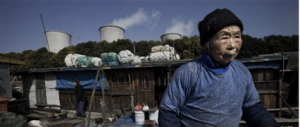The Olympic Games in Beijing and World Expo in Shanghai drew attention to one of China’s biggest environmental problems – urban air quality. As part of the strategy to alleviate this, high-polluting factories, remnants from the cities’ industrial pasts, were moved to new facilities in modern manufacturing hubs. Yet in doing this, the country unknowingly created another environmental challenge: dealing with the contaminated sites these factories left behind.
As China’s cities cope with rapid urbanisation, these sites, known as brownfields, are receiving closer attention. Though initially created in designated industrial areas or the outskirts of cities, urban expansion has incorporated them into the city fabric, while also pushing cities into conflict with decreasing amounts of agricultural land. As vice minister of China’s Ministry of Housing and Urban and Rural Development Qiu Baoxing has stated, the conflict between urban growth and arable land is “very tight”.
Development of brownfields could help alleviate this pressure on arable lands, while simultaneously addressing the need for floor space in China’s rapidly growing cities.
Yet brownfield redevelopment is a complicated task, made more difficult by the high levels of pollution in some of China’s sites. A recent article in the Shanghai Daily indicated that some contaminated areas may have soil pollution at depths of up to 10 metres, with pollutant levels over 100 times acceptable limits. Despite these levels of contamination, there is not yet a unified policy to manage brownfield clean-up efforts.
According to a World Bank report released in September, “China’s legal and regulatory system for soil pollution prevention and control is in its infancy. There is no national law encompassing land contamination and brownfield remediation and redevelopment.” Considering the current state of China’s policy, the World Bank concluded that, “there are no comprehensive technical guidelines or standards on soil pollution monitoring, environmental risk assessment and soil remediation techniques officially issued at a national level.”
However, like everything in China, this is rapidly changing. In recent years, the Ministry of Environmental Protection (MEP) has been considering and guiding contaminated land investigations and remediation policy in China and the publication of management and technical guidelines is expected by the end of the year.
In an interview with chinadialogue, Shaun Xie, deputy director of the Committee of Soil and Groundwater Environments of China (CSGEC) and managing director at Environmental Resources Management (ERM) China said: “The Chinese government has been considering all standards and technical guidelines including those from the ASTM [formerly the American Society for Testing and Materials] in the US and those used in other developed countries.” This is evidenced as well by a visit in December 2010 by a delegation from China to the United States and Canada to learn about brownfield clean-up in North America.
The United States and United Kingdom, two of the countries China is looking to for guidance, are no strangers to brownfield remediation. In the US, comprehensive brownfield policy dates to the establishment of the Superfund programme in the late 1970s, created in response to the Love Canal disaster. Citizen outrage followed the discovery of 21,000 tonnes of chemical waste and a higher incidence of disease and birth defects on the site of the Love Canal community housing project in New York. Such unsafe conditions prompted the government to closely regulate redevelopment and led to government-ordered remediation of 347 sites, with an additional 1,280 currently under supervision.
Seventy percent of these have been paid for by the polluters, thereby lowering the burden on taxpayers and cultivating environmental responsibility within the corporate world. Such funding mechanisms could provide a model for China that will force remediation and improve pollution controls by disincentivising the “pollute now, pay later” model.
In the United Kingdom, managers of the Olympic Park – currently under construction for the 2012 Games – are in the process of remediating an unprecedented 2 million tonnes of soil on-site. Once home to industrial warehouses, shipping yards and factories, after remediation this area is slated to host the greenest Olympics in history and include the largest new urban park in Europe in over 150 years, according to David Stubbs, head of sustainability for the London 2012 Organising Committee.
But in addition to looking at other nations for policy suggestions, both the World Bank and Xie highlighted regional successes in China’s brownfield accomplishments. For the World Expo, Shanghai established a soil pollution remediation centre to develop capacity for cleaning the contaminated Expo grounds. Similar efforts have been seen in Beijing, Chongqing and Jiangsu. Furthermore, Xie stressed, these areas have instituted their own management rules that tie together planning, building and remediation. “The governments already see many cases where people get poisoned, sick and concerned to build their apartment or house in a previously contaminated site,” he said.
In addition to helping Shanghai develop knowledge of brownfield remediation, the World Expo highlighted two areas in China where former industrial sites are being made over into vibrant centres of community life. A week-long exhibition flagged up the transformation of the central area of Tangshan in Hebei, north China, from an abandoned coal pit and temporary landfill to a new ecological and community park. Involved in this process was the removal of rubble and contaminated soil to be replaced with new soil and clay, natural vegetation and community functions. This transformation has garnered awards from the Chinese and Dubai governments and UN-HABITAT.
A more recent and better-known example is the ongoing development of the Sino-Singapore Tianjin Eco-City. The city was intentionally sited on polluted marshlands because, according to vice housing minister Qiu Baoxing, “It is of no importance to develop a modern city on a fertile land, but it is of great reference to develop an eco-city on an unproductive alkaline land.” In the process, the development team has been forced to remove the contaminated, alkaline soil, filter and clean it, and replace the topsoil.
Though these case studies demonstrate how brownfield redevelopment can transform communities, neither provides good guidelines for technical or managerial processes for remediation. According to both the World Bank and Xie, technical management of remediation is one of the major challenges in China. “At this moment, much of the remediation will consist of excavating the soil and dumping it because the development need is urgent to make commercial or residential areas,” Xie said. As a result, many of the projects involve incineration or “dig and dump”.
On the whole, he said, there is no time to do real technical remediation on site as this can add several years to the project time. According to Johnny Browaeys, former vice president of environmental services at global engineering and construction consultant CH2M Hill, the situation is complicated by the fact China lacks specialised facilities to treat polluted soil ex situ and has limited hazardous waste-disposal sites equipped to receive contaminated soil.
But the forecast is not entirely grim. Xie believes the expected publication by the MEP of a new remediation policy will help to spread best practice. He said that some companies in China are already carrying out proper remediation, but this is mostly limited to international firms with a directive for such work and large Chinese state-owned enterprises. Many domestic Chinese companies are not driven by corporate social responsibility (CSR) as multinationals are, and so for these companies the policy will play an important role. Without the regulations, said Xie, they are not typically willing to spend the money for on-site remediation.
According to Browaeys, the key to unlocking the potential of Chinese companies in brownfield remediation is solving the funding issue. Traditionally, pollution has been something without value from a government and business perspective. Yet last year a workshop on remediation was organised by the Nanjing Institute of Soil Science and CH2M Hill, focusing not only on technologies but also on policies and funding mechanisms. Several cases of remediation funded in part by the government, the polluter and the developer were presented.
But putting in place a policy that provides both goals for remediation and a financial model is only half the battle. Technical knowledge is required to ensure that sites are cleaned up properly. Tom Darden, chief executive at Cherokee, a US-based private equity investment firm specialising in brownfield development, said that experience is key to avoiding wrong approaches that not only cost time and money, but can actually make contamination worse. Remediation technology cannot just be copied from one site to another.
In a recent visit to China, Darden noted an increasing understanding of brownfield issues. The key, he feels, is to learn how to take systems and knowledge from other nations and apply them in China. In his experience, western companies have typically managed the site assessment and sometimes the remediation, but increasingly Chinese players are entering this market.
Furthermore, he said that a fair number of people who have worked for western companies in the field are returning to China and seeing the market there. As a result, “there is a lot of transfer of technology and knowledge.”
Browaeys agreed that this transfer is important, but cautioned that it must be managed carefully. “Just because something works outside of China does not meant it will work in China. Division of labour and technology is different, experience differs and the remedial objectives often are different.” He believes the best strategy is for experienced companies like CH2M Hill to partner with local companies. “Our partners are very strong in doing their projects and have the right connections with local governments and knowledge institutions.”
Though there are many hurdles still to overcome for China’s brownfield redevelopment, the country is moving quickly in the right direction. Xie expects the MEP to issues its guidelines before the end of the year. Browaeys also noted that, in June, an update to the Environmental Impact Assessment Law will come into force which, for the first time in China, will systematically include assessment of groundwater quality in the project approval process, and require project owners to include remediation measures for groundwater contamination.
And so, while the status of China’s brownfields currently seems dire, it is likely to be much brighter by the end of the year. With the right policy, Browaeys said, “you can link environmental performance with business. Things then go very fast because it becomes self-inflating, especially in China.” Darden agreed: “I came away with a lot of optimism, thinking ‘this is just getting started, but [China] is going to clean up a lot of pollution.’”
Robert Best is a Thomas J Watson Fellow from Harvey Mudd College, California.
Homepage image from melaniedornier.photoshelter.com shows a disused factory site in Suzhou.


